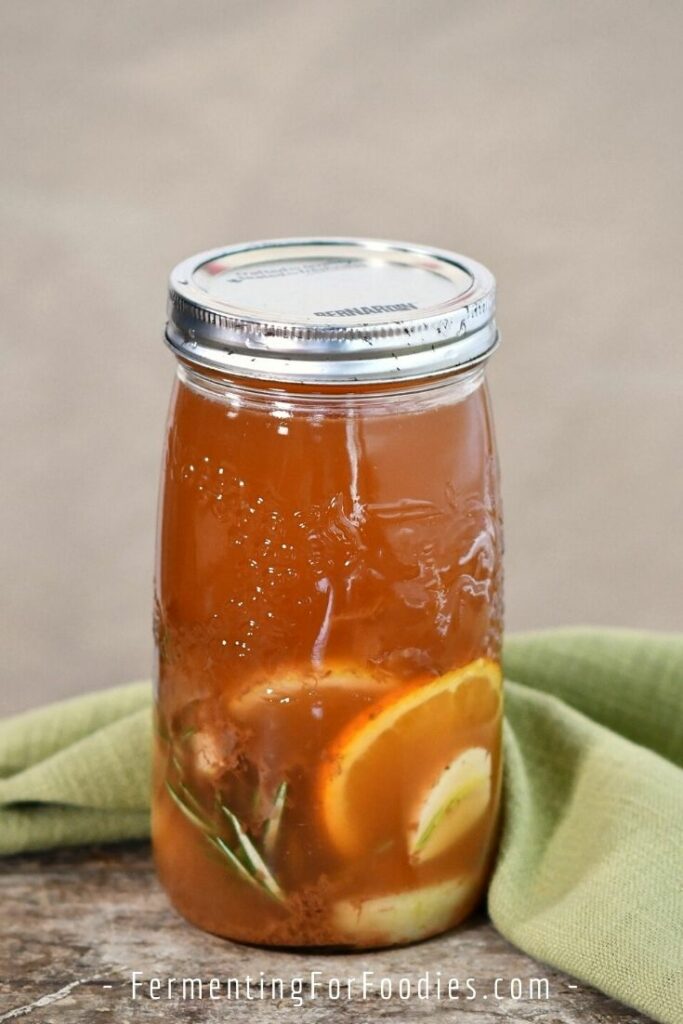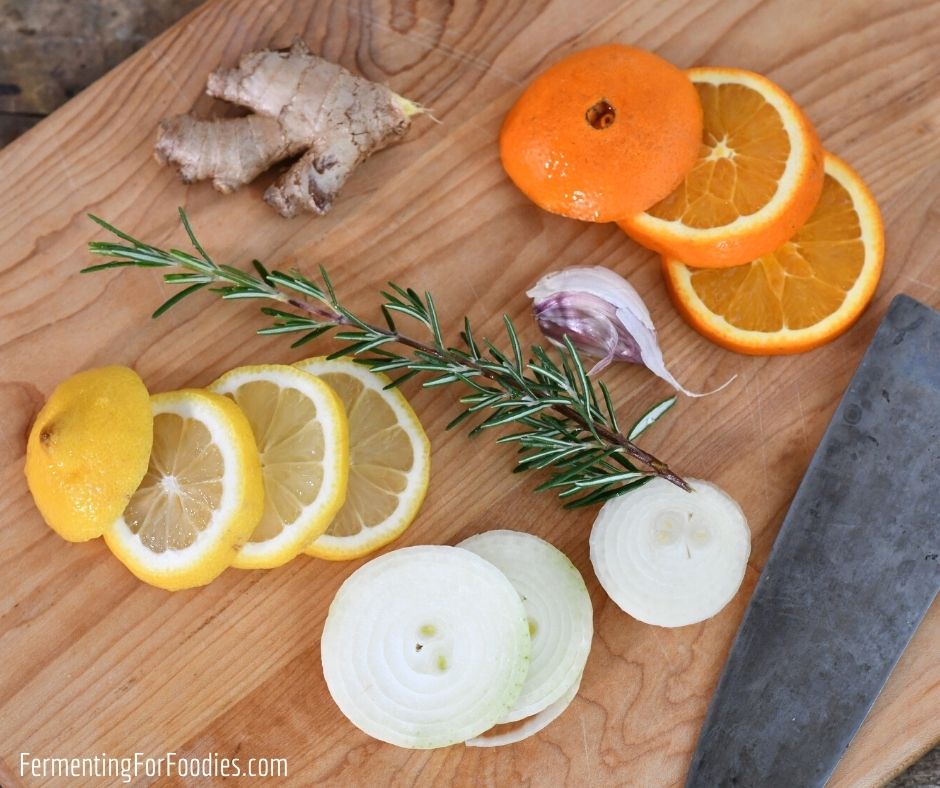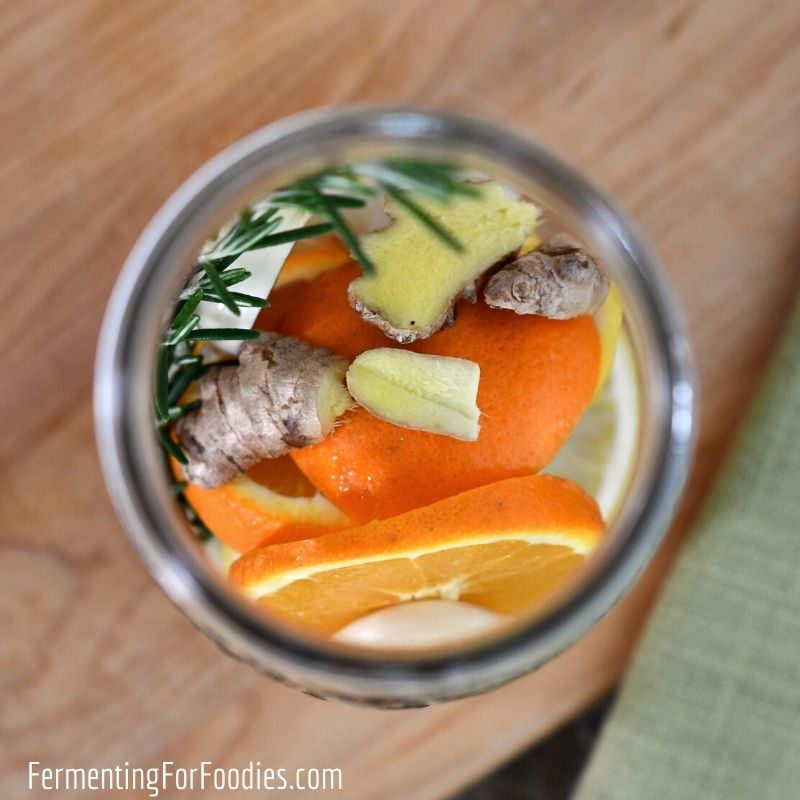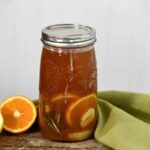Fire cider is a folk remedy that focuses on packing as many beneficial ingredients into a jar as possible for a flavor-packed apple cider vinegar infusion.

This is my take on fire cider, and it’s a bit different from the original one because my recipe doesn’t include honey. So it is not sweet at all. Here are a few reasons for not including honey:
- The antimicrobial properties of raw honey only work in an undiluted form. As soon as the honey is mixed with something else, it becomes probiotic.
- However, mixing honey with apple cider vinegar does not allow for it to be probiotic either. The acidity of nearly straight vinegar is high enough to kill the natural strains of yeast and bacteria.
- Honey doesn’t improve the flavor of fire cider or turn it into drinking vinegar. If you want a bit of sweetness, add the honey when mixing it up for a drink.
- Honey-free fire cider is suitable for vegans, pregnant women, and anyone with immunity issues. It’s also sugar-free!
Playing with flavor
While the traditional fire cider recipe contains: garlic, onion, horseradish, and cayenne pepper, I like to play with flavor. So I’ve added a few extra ingredients to make my fire cider a bit more flavorful! Here are a few more ways to take this basic fire cider recipe and switch up the flavors:
- Citrus: I love citrus-flavored ACV. Skip adding the garlic, horseradish, and onion, instead include a whole orange sliced in circles and a whole lemon sliced in circles. It’s perfect with ginger and rosemary.
- Spicy: For a hot and spicy cider add 1 or 2 chili peppers sliced in half. Skip adding the orange and rosemary in a very fiery cider.
- Herbal Infusion: For a herbal infusion add 2 more sprigs of rosemary with 3 sprigs each of thyme, oregano, parsley, and marjoram.

How to Enjoy Fire Cider
Fire cider is traditionally used as a health tonic to boost your immune system. However, it also has many delicious culinary uses. Here are a few of my favorite ways to enjoy this vinegar infusion:
- For a health tonic: A shot of fire cider is a great way to get a dose of vitamin C during the flu season. Take a tablespoon straight up or mix it into a glass of water or juice. In either case, I recommend rinsing your mouth with water afterward to protect your teeth from the acidity.
- Salad dressing: Mix 2 Tbsp of fire cider with 1/4 cup of olive oil, 1 tsp of Dijon mustard, and a pinch of salt for a flavorful salad dressing.
- Drink flavor: Add 1 Tbsp to a glass of ginger ale, sparkling water, or apple juice. Just avoid mixing it with other acidic juices since it’s already quite acidic.
- Cooked vegetables: Add a drizzle to roasted or steamed vegetables to give them a burst of flavor.
- Marinade: Make a simple marinade with 1 cup of olive oil, 1/2 cup of fire cider, 1 tsp salt, and 1 Tbsp Dijon mustard.
- Tea: I like adding 1 tsp to a cup of chai or rooibos tea.

Fire Cider: A Flavor Infusion
This fire cider recipe is packed full of immune-boosting and flavorful additions. The only thing it doesn’t have is honey! While honey can be added afterward, not including it means that this recipe is vegan, keto, and sugar-free. It’s also probiotic!
- Prep Time: 5 minutes
- Total Time: 5 minutes
- Yield: 3 cups 1x
- Category: Beverage
- Method: Infusion
- Cuisine: Healthy
- Diet: Vegan
Ingredients
- 1/2 onion, sliced
- 2 cloves of garlic, crushed
- 1-inch of ginger root sliced in half
- 1-inch of fresh horseradish root, grated
- 1 sprig of rosemary
- 1/2 of a lemon, sliced in circles
- 1/2 of an orange, sliced in circles
- Optional additions: hot peppers, 1-inch fresh turmeric root, black peppercorns, cinnamon stick
- 3 cups of raw apple cider vinegar, enough to cover.
Instructions
- As a traditional folk remedy, fire cider would have been made with whatever was on hand. So including all of the ingredients on the list isn’t necessary. If you can’t find one of them, it’s fine to leave it out.
- Pack all of the ingredients into a 1-quart jar. Pour over the apple cider vinegar. You should have enough to completely cover everything.
- Use a weight to keep everything under the vinegar. Place the jar in a closet to infuse. It needs at least 3 weeks to infuse but can be left for up to a year. The acidity in the vinegar will prevent it from going off.
- When you’re ready to use your fire cider simply pour the vinegar through a fine mesh strainer into a clean bottle, squeezing out as much liquid as you can from the fruits and vegetables. Store the finished fire cider in a dark cupboard at room temperature. See the section above for serving suggestions.
Notes
- Since this is not a ferment, fire cider can be made in any type of jar. A regular mason jar or a clean mayonnaise jar is fine. Just be sure to use a lid to keep the fruit flies out.
- Not all apple cider vinegar is probiotic. Look for brands that say raw or with mother as these will have a live culture. Alternatively, you could always make your own. If you want to primarily use your fire cider as a drinking vinegar, I recommend using scrap apple vinegar. It’s less acidic, which means it’s easier to drink.
- Most recipes include honey. While raw honey is full of probiotic cultures… that doesn’t mean it will be probiotic after it’s mixed into vinegar. See the section above for details on the best way to add honey to your infusion.


Great idea!